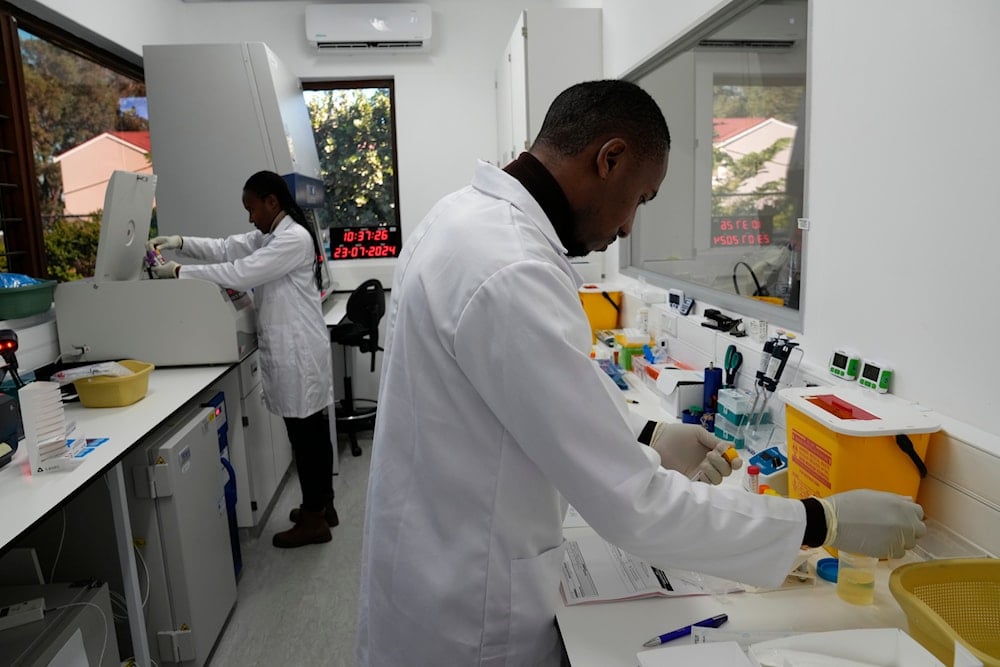HIV testing drops in South Africa amid US aid cuts: Reuters
US aid cuts have led to a decline in HIV testing and patient monitoring in South Africa, with pregnant women, infants, and youth among the hardest hit.
-

Lab technician Xolile Mhlanga works with vials of lenacapavir at the Desmond Tutu Health Foundation's Masiphumelele Research Site, in Cape Town, South Africa, Tuesday, July 23, 2024 (AP)
HIV testing and patient monitoring in South Africa have significantly declined following cuts in US aid funding, with the hardest-hit groups being pregnant women, infants, and youth, according to previously unpublished government data seen by Reuters.
South Africa has the world's highest HIV burden, with approximately 8 million people, or one in five adults, living with the virus.
Until earlier this year, the US had funded 17% of South Africa’s HIV budget until President Donald Trump’s administration cut this support, severely impacting health services.
Early in his presidency, Trump suspended several foreign aid programs, only restoring critical components of the President’s Emergency Plan for AIDS Relief (PEPFAR) later, but South Africa faced targeted cuts in February, when an executive order eliminated all US funding to the country.
US aid funding cuts put mothers, children at risk
Despite South Africa not relying on US funding for HIV medications, PEPFAR had contributed over $400 million annually to cover the salaries of approximately 15,000 health workers. Most of that funding has been withdrawn, though it is unclear exactly how much.
Reuters reviewed government data that revealed a significant drop in viral load testing among key groups in the past two months, which HIV experts linked to the reduction in US funding.
Data reviewed by Reuters showed a 17.2% decline in viral load tests for people aged 15-24 in April compared to the same month last year, following a 7.8% year-on-year decrease in March.
The total population testing also fell by 11.4% in April. Additionally, maternal viral load testing dropped by 21.3% in April after a 9.1% decline in March, while early infant diagnostic testing fell 19.9% in April after a 12.4% drop in March.
"These are shocking figures, with profound implications for maternal and child health across the country," said Francois Venter, executive director of the Ezintsha Research Centre in Johannesburg, in an interview for Reuters.
Clinics, health centers strained by employee shortage
In response to the funding cuts, health clinics across South Africa, especially in Cape Town, are struggling with staff shortages.
According to epidemiologist Dvora Joseph Davey from the University of Cape Town, US aid funding cuts have led to shortages at five Cape Town clinics, directly affecting their ability to conduct vital viral load testing.
Davey explained to Reuters that counsellors, who were previously responsible for conducting rapid HIV tests and initiating pregnant women on preventative HIV medication (PrEP), are no longer available.
This has left many critical services understaffed, exacerbating the challenges facing those most at risk for HIV.
HIV activist and Diepsloot community leader Sophy Moatshe also emphasized the growing difficulties in encouraging HIV patients to seek care due to social stigma, explaining to Reuters that, with fewer health workers following up on missed appointments, many patients are being lost to treatment.
"These people, they don't want to go to the clinic," she told Reuters, adding that without anyone checking up on them, "they are going to die."
The future ahead
While South Africa's Department of Health spokesperson, Foster Mohale, stated that the government is exploring options for addressing funding gaps through potential local and international donors, the challenges remain significant.
Mohale indicated that more analysis would be required, but the country had already been facing difficulties with patient retention and viral load testing even before the funding cuts.
Epidemiologists and HIV experts have warned for months that the South African government is underestimating the full consequences of the funding reductions, and according to Reuters, they suggest that the decline in testing numbers could result in a future increase in new infections and deaths.
While Mohale stated the government was in talks with potential local and international donors to address funding gaps without providing specifics, epidemiologist Davey warned that the April testing data already serve as a clear indicator of future trends.

 4 Min Read
4 Min Read








